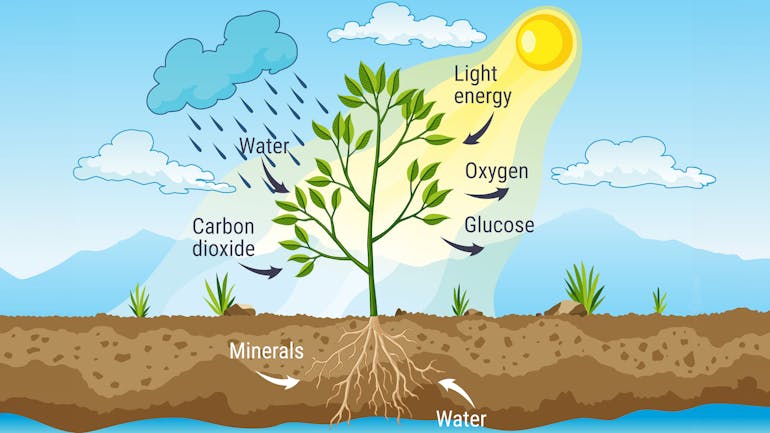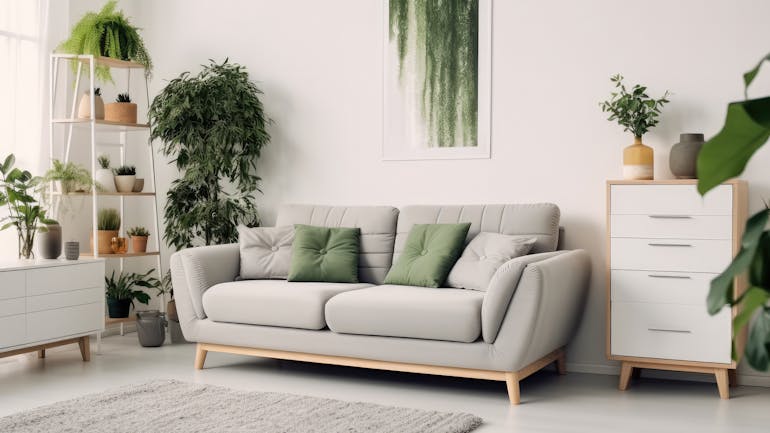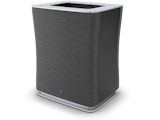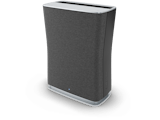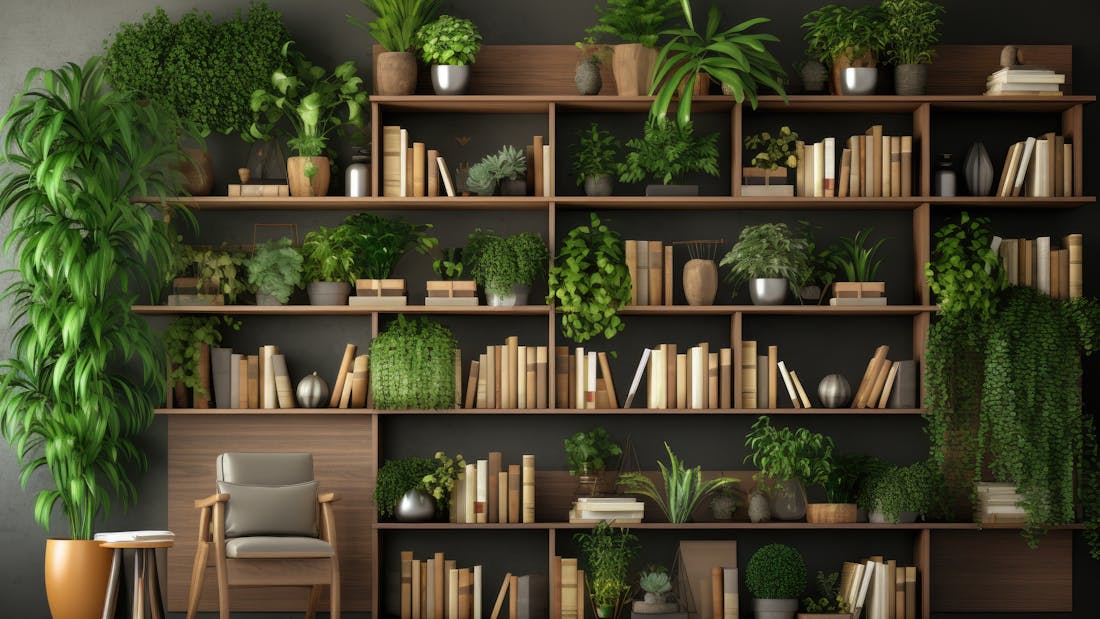
Usha Müller, 23 November 2023
Purify the air
Plants as air purifiers: myth or reality?
Those who beautify their rooms with plants are also doing something good for their health. It has been known for many years that plants serve as effective air purifiers and thus not only contribute to a pleasant atmosphere, but also demonstrably ensure purified indoor air. Recently published study results have sparked a debate about how useful the use of plants as air purifiers actually is and whether some houseplants really are a guarantee for clean and healthy indoor air.
Read on to find out:
- Plants and air quality: a look at selected species and studies
- The limited capacity of houseplants as air purifiers
- Houseplants and air purifiers for a good indoor climate
Plants and air quality: a look at selected species and studies
Many air-purifying plants originate from tropical or subtropical regions. These plants thrive with little sunlight and are therefore well suited to indoor spaces. Some of these plants are particularly known for filtering pollutants from the air and thus purifying indoor air. Indoor plants that purify the air include, for example, ivy, hemp, monocots, green lilies, ivy and rubber trees. Some of these plants are said to be real helpers in improving the indoor climate. Ivy is known to remove impurities from indoor air; it is even said to be able to eliminate mould spores. Its low-maintenance existence makes it very popular, even with people without green fingers. The hemp plant is also often touted as an air-purifying plant that produces a lot of oxygen. And green lilies filter the air and ensure a pleasant level of humidity in the room.
Air-purifying houseplants have been presented as the solution to polluted indoor air for decades. They bind pollutants and thus purify the air. This happens through the process of photosynthesis. Through photosynthesis, the plants absorb carbon dioxide (CO2) from the air and convert it into oxygen, among other things, with the help of light. This reduces the toxins in the air and at the same time enriches the room air with oxygen, resulting in better indoor air quality.
The air-purifying effect of plants has been investigated in various studies. The NASA study from 1989, which is said to prove the air-purifying effect of plants indoors, is cited particularly often. The study analysed the effects of plants on indoor air quality in closed rooms. The concentration of pollutants such as formaldehyde, benzene and trichloroethylene were measured before and after the use of plants in the rooms. The result of the study was that certain plants are not only able to convert carbon dioxide into oxygen but are also able to filter toxins from the air and thus reduce the concentration of pollutants in the air. However, what is not considered is that the study was carried out under experimental conditions and therefore does not reflect the reality in homes or offices.
For more than 30 years, it was considered an unassailable truth that houseplants are the best air purifiers for the home. The opinion that houseplants have an air-purifying effect and not only optimally humidify the air, but also remove all toxins from the air, has persisted. Now a new meta-study has called into question the effectiveness of plants as air purifiers.
The limited capacity of houseplants as air purifiers
Although plants can filter pollutants from the air, they have a limited capacity for air purification. In a recent meta-study led by environmental engineer and indoor air quality expert Michael Waring, a dozen studies were analysed for their findings on air-purifying plants. The results were sobering: All tests on the air-purifying effect of indoor plants were carried out under controlled, experimental conditions, i.e. in hermetically sealed rooms, which does not correspond to the conditions in a flat or office. When applying the results to our homes and offices, factors such as room size, air exchange and sources of pollutants were completely disregarded. However, these factors significantly influence the effectiveness of indoor plants as air purifiers. The results of these studies are therefore of little significance for indoor spaces in which people actually live.
In principle, it is true that certain houseplants have an air-purifying effect and can filter pollutants out of the air; however, the effect is much smaller than has been assumed for decades. To have a real impact on air quality, around one hundred plants per square meter would be required. A 50 m2 flat would therefore need up to 5000 plants. So, if you want to live in a forest, you can try using plants as air purifiers. For everyone else, it makes more sense to use an air purifier in addition to the plants in order to enjoy purified indoor air. Nevertheless, plants are relevant in living spaces because their positive effect on the psyche can be of great importance. Plants can even help to reduce stress and to relax.
It is important to understand that plants alone are not enough to guarantee a healthy and good indoor air quality. To significantly improve air quality, regular airing and the use of an air purifier or air washer are clearly more efficient. Both air purifiers and air washers are able to filter pollutants effectively and selectively, thereby purifying the indoor air.
Houseplants and air purifiers for a good indoor climate
A room full of thriving plants can have a big impact on your well-being. However, it takes more than the feeling of a jungle to purify the air. An air purifier can be used to support this. Air purifiers equipped with a HEPA filter, in particular, clean the air efficiently. For a healthy indoor climate, an air purifier should be used to complement your favourite plants.
Here are the relevant factors to explain.
- Efficiency: Air purifiers use state-of-the-art filter technologies to remove pollutants such as VOCs from the air. This is done with a high efficiency, which in many cases exceeds the ability of plants. In order to test the efficiency of air purifier plants, the respective CADR value was determined, which is used to measure the efficiency of air purifiers. This indicates how much purified air is released into the room air by an air purifier in a certain time. Waring's team also states in their meta-study: "Plants do remove VOCs, but they do so slowly that they cannot keep up with the normal air exchange mechanisms in a building". To match the efficiency of an air purifier, a large number of plants would have to be used, which can clean the air much more quickly.
- Targeted cleaning: Plants can filter toxins from the air. However, each plant can only extract certain substances from the air and does so at its own, uninfluenceable rate. A philodendron may look beautiful, but it can only filter formaldehydes from the air and no other toxins such as benzene, toluene and ammonia. Unlike plants, air purifiers can specifically remove a wide range of pollutants from the air. This improves indoor air quality in a targeted manner.
- Adaptability: Air purifiers are designed to adapt to different room sizes and environmental conditions to ensure optimum performance. There is a suitable device for every room. Air purifier Roger big is suitable for large offices, entrance halls or other large rooms up to 104 m2. If clean air is only required in small rooms up to 33 m2, Roger little is sufficient. If the room air is not only to be purified but also enriched with moisture, it is advisable to purchase an air washer. Particularly in winter, when the humidity in the room drops, these 2-in-1 devices can ensure a healthy indoor climate by cleaning the air and additionally supplying it with moisture.
Plants can have a significant impact on our well-being. Our mental health can be positively influenced by the arrival of green roommates in our homes, and they are a real feast for the eyes. However, to get reliably purified and, if necessary, humidified air, the use of an air purifier or air washer is the right solution.
Would you like to find out more about how you can get purified and healthy air indoors?
If you have questions related to indoor room climate, please get in touch with us. Or subscribe to our newsletter to regularly get informed about current topics regarding indoor climate, experience reports or Stadler Form insights.

